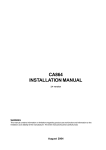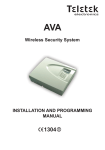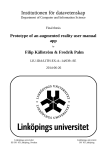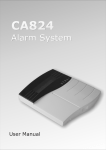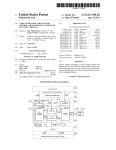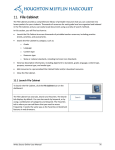Download ca824 installation manual
Transcript
CA824 INSTALLATION MANUAL 3.3 version WARNING This manual contains information on limitations regarding product use and function and information on the limitations as to liability of the manufacturer. The entire manual should be carefully read. September 2004 CONTENTS INTRODUCTION ..................................................................................................................................... 3 RCOMMENDATIONS FOR INSTALLING THE CA824 ALARM SYSTEM................................................ 3 PHYSICAL AND LOGICAL SYSTEM LEVEL ........................................................................................... 4 BEFORE PROGRAMMING THE CA824 ALARM SYSTEM .................................................................... 5 STEP-BY-STEP PROGRAMMING OF SYSTEM PARAMETERS .......................................................... 6 LEAVING PROGRAMMING MODE .......................................................................................................... 6 NEW PnP HARDWARE IDENTIFICATION PROCEDURE .................................................................... 6 REMOVING MODULES FROM THE SYSTEM ....................................................................................... 7 DISABLING SYSTEM MODULES ............................................................................................................ 7 CA824 ALARM SYSTEM CHARACTERISTICS ...................................................................................... 7 CA824 control panel box .......................................................................................................................... 8 CA824 control panel .............................................................................................................................. 11 CA824 control panel resources ............................................................................................................. 12 Power supply unit .................................................................................................................................. 12 CA824 control panel fuses .................................................................................................................... 12 CA824 control panel indications ............................................................................................................ 12 CA824 control panel terminals .............................................................................................................. 12 Technical specification of CA824 control panel ..................................................................................... 13 LCD824 keypad module ........................................................................................................................ 14 LCD824 keypad module resources ....................................................................................................... 14 Technical specifications of LCD824 keypad module ............................................................................. 15 LED816 keypad module ........................................................................................................................ 16 LED816 keypad module resources ....................................................................................................... 16 Technical specifications of LED816 keypad module ............................................................................. 17 MRI4/8 input (ZONE) expander module ................................................................................................. 18 MRI4/8 input expander module resources ............................................................................................ 18 Technical specifications of MRI4/8 input expander module ................................................................... 18 MRO8 output expander module resources ........................................................................................... 19 MRO8 output expander module (PGM) ................................................................................................. 19 Technical specifications of MRO8 output expander module ................................................................. 19 Installation box for input and output expander modules ........................................................................ 20 Technical specifications of the expander installation box ...................................................................... 20 DIO32 module (Dynamic indication) ..................................................................................................... 21 Use of DIO32 module ............................................................................................................................ 21 DIO32 module resources ...................................................................................................................... 21 Adjusting the DIO32 module .................................................................................................................. 22 Technical specifications of DIO32 module ............................................................................................ 22 PR864 Proxi Reader Module ................................................................................................................. 23 Purpose of PR864 Proxi Reader Module .............................................................................................. 23 Resources of PR864 Proxi Reader Module .......................................................................................... 23 Technical specifications of PR864 Proxi Reader module ..................................................................... 23 SUPPLEMENT A - Menu structure chart for programming the CA824 alarm system .......................... 24 ENGINEER PROGRAMMING MENU STRUCTURE CHART ............................................................... 25 SUPPLEMENT B – Chart for user programmable menus .................................................................... 27 2 CA824 Installation manual INTRODUCTION This manual presents the information needed to install CA824 Alarm System modules. The manual consists of two parts: - general information about installing system modules - description of devices and installation details The manual includes a chart of the structure of menus, which will help detect and access system configurations. The following keys are used for programming: A left arrow for back moves within the menu structure A right arrow for forward moves within the menu structure ENT The ENT key for confirmation of any corrections / a transition to the following level of menu structure CLR The CLR key for rejection of any corrections / a transition to prior level menu structure RCOMMENDATIONS FOR INSTALLING THE CA824 ALARM SYSTEM The CA824 Alarm system has been designed and tested according to electromagnetic compatibility standards. The following recommendations need to be observed for the proper performance of the alarm system: 1. Make sure the alarm system is securely earthed (neutral). 2. Insulate the low and high voltage cables and use different input box plug-ins. 3. Avoid any connecting conductor loops in the box or their positioning above or below the printed-circuit board. 4. No additional relays should be placed in the CA824 Alarm system box, as switching these may cause electromagnetic interference. 4.1. Use only relays with good insulation between plugs and winding. 4.2. The relays connected to open collector outputs must be designed for 12 V DC control voltage and winding impedance greater than 400 Ω. 5. A quad conductor cable connects the motherboard with the modules. Using this cable for making any other connections such as a telephone line, control flashlight signals, sirens or relays is not recommended. 6. When placing the connecting cables avoid canals or cable forms housing high voltage wirings. This is especially important where these cables are to be used for supplying power to electric motors, luminescent lamps or three-phase voltage. Where this is impossible, use sheathed wiring where the sheath should be earthed only in the alarm system box. CA824 Installation manual 3 PHYSICAL AND LOGICAL SYSTEM LEVEL Any security system established on CA824 principles should be regarded as a physical and logical entity. At its physical level it comprises of all modules, together with all their resources – inputs and outputs. Limitations at this level consist of the number of modules, which can be connected to the bus – no more than 15. As to the resources – there are no limitations at this level to the number of inputs or puts. In practice, this would mean that the actual number of modules connected to the bus could be backed up by more inputs and outputs than those maintained at the logical level. The logical level of the system includes the zones, their types, their attached areas, etc; the programmable outputs (PGM) together with their performance logics; the user codes with all their adjustments; the specified areas, etc. In other words, the logical level allocates the resources at a physical level and configures performance of the system as a security station. Zones are limited up to 24 logical numbers, whereas programmable outputs (PGM) are up to 16 logical numbers. the logical number 00 is used to initialize the resources of any arbitrary module, which are not to be utilized. The modules engaged by the system can be activated in “double zoning” performance mode or deactivated in that mode. The “double zoning” mode is universal for all devices and means that two sensors can be connected to any input of a given device. Hence, 2*N sensors can be connected to a module which has N number of inputs. Two menu inputs correspond to one physical input. These are located at address 8.0.xx.0, where device inputs can be configured and therefore 2*N zones can be attached to module inputs in programming mode. Where the double zoning option has not been activated, only one sensor can be connected to one input, thus attaching only one zone to this input, when in programming mode. Therefore, where one module has N inputs in this mode, no more than N sensors can be connected to it. Only one zone can be connected to one input, irrespective of whether the double zoning mode is active or not. Figure 2 in Item 4.3 – Zone Hardware – describes how to connect sensors. Module inputs will be processed only after they are assigned a number for the zone they are connected to. This is done separately for each individual module at address 8.0.xx.0, Inputs config. XX designates the number of the module from the list of devices included in the system. The parameters of the respective zone also have to be assigned at address 4.1. This address is inaccessible for modules without inputs. Table 1. Correspondence between the physical inputs and the input numbers of the menu located at address 8.0.xx.0 for double zoning mode. Physical input number 1 2 ..... N Input number from the menu for Zone 1 1 2 ..... N Input number from the menu for Zone 2 N+1 N+2 ..... 2*N Elaboration on Table 1. The columns indicate which inputs of the menu, rows 2 & 3, correspond to a given physical input in row 1. In Figure 2, input numbers for Zone 1 are in row 2. Input numbers for Zone 1 in Figure 2 are in row 3. For example – 1 and N+1 inputs from the menu at address 8.0.xx.0 correspond to first physical input. Input number 1 corresponds to Zone 1 and input number N+1 corresponds to Zone 2. Table 2. Correspondence between the physical inputs and the numbers of the inputs in the menu located at address 8.0.xx.0 for deactivated double zoning mode. Physical input number Input number from the menu 4 1 2 ..... N 1 2 ..... N CA824 Installation manual Module inputs are processed only after they are assigned the number of the zone to which they are connected. This is done for every module separately at address 8.0.xx.0. Input config. XX designates the number of the module within the list of devices, which have been included in the system. The parameters of the respective zone also need to be assigned, at address 5.1. This address is inaccessible for modules with no outputs. Any arbitrary number of physical outputs can be connected to one PGM. These outputs can belong to different system devices. BEFORE PROGRAMMING THE CA824 ALARM SYSTEM Carefully read this manual to learn about system options and programming procedures. Any necessary changes to system configurations have to be set prior to programming, in order to comply with the specifications of your security system. Alterations to system configurations can be done at any time. Fig. 1 shows LCD buttons on the keyboard. Both figures and letters can be keyed in. The letters, and their respective figure association, are shown in Fig. 1. Any figure or letter can be introduced depending on the number of clicks on the button. The PRG button changes capital to small case and vice-verse. Special symbols like space or coma can be introduced via the 1 and 0 buttons. The correspondence between the number of button clicks and the symbol to be displayed is shown in Table 1. The arrows will move the cursor within the edited section. Pressing ENT confirms any changes. Pressing CLR rejects the changes. Fig. 1. LCD keyboard buttons Table 3. Correspondence between the number of button clicks and the respective symbol Button Number of clicks CA824 Installation manual 0 1 2 3 4 5 6 7 8 9 1 0 1 2 3 4 5 6 7 8 9 2 3 . 4 , - = A D G J M P T W B E H K N Q U X + C F I L O R V Y 5 : $ ? ? ? ? ? S ? Z 6 ! % ? ? ? ? ? ? ? ? 7 < @ ? ? ? ? ? ? ? ? 8 > / ? ? ? ? ? ? ? ? 5 STEP-BY-STEP PROGRAMMING OF SYSTEM PARAMETERS I. It is necessary to design a model of your security system and to establish a scheme describing this model in order to begin programming (showing the type and number of sensors, their interconnections, any specific requirements towards system configuration). Then the system can be integrated and programmed. II. If the system is to be programmed for the first time, it would be necessary to Load factory settings. III. Loading factory settings Use the RESET jumper on the motherboard. Proceed as follows: - Power down the system – both battery and mains; - Place the RESET jumper on the motherboard; - Power up the system, wait 8 seconds and remove the RESET jumper. System factory configurations have now been restored, all modules identified and the system configured. The Engineer Code is 7777. The manager code is 0000. System factory configurations for inputs and outputs are issued in Table 2 and Table 3. The RESET jumper is used only to perform RESET and should be removed during system operation. IV. All areas must be disarmed when adjustments to any settings of the system, which has already been programmed, are going to be made. Access will thus be enabled to the engineer menu, where programming is done. V. Introduce engineer code to access engineer menu. Once in programming mode, it is recommended to observe the following steps in order to reduce the risks of mistake or omission. VI. Assign zone numbers, the logical inputs are to be connected to, and the number of the PGM, to which the device outputs are to be directed, by observing the requirements of your own security system. This procedure is described in Item 8. VII. Program areas within the system. This procedure is described in Item 6. VIII. Program station user codes. The procedure is described in Item 3. IX. Program zones according to requirements – make changes to the names of the zones, to the type and attributes of the zones, define system area attachment. The procedure is described in Item 4. X. Program PGM. The procedure is described in Item 5. XI. Program system timers (entry time, exit time, bell time, date, etc.). The procedure is described in Item 2. XII. Program other parameters. XIII. Exit programming mode after the system is programmed in order for your new adjustments to be adopted. XIV. Access the engineer menu and check the performance of the zones. The procedure is described in Item 1. XV. Exit engineer menu and test the performance of the system according to your requirements. XVI. Go back to programming mode and set the dialer. The procedure is described in Item 7. During Engineer programming mode is active activations of Zones and Tampers will not affect in the system. After Engineer programming mode is leaved all active zones and Tampers will affect in the system. Only one LCD keypad can be in Engineer programming at the same time. Engineer programming mode is allowed only when all areas in the system ar disarmed. 6 CA824 Installation manual Table 2 System factory configurations for inputs Input? Zone? Type Area 1 1 Entry/Exit 1 2 2 Follow 1 3 3 Instant 1 4 4 Instant 1 5 5 Instant 1 6 6 Instant 1 7 7 Panic 1 8 8 Tamper 1 Table 3 System factory configurations for outputs Output ? PGM? Parameters of PGM 1 1 ARM area 1 2 2 Alarm, Tamper 3 3 Technical trouble 4 4 Siren Zone parameters AutoZoneShutdown, Chime, Audible AutoZoneShutdown, Stay, Audible AutoZoneShutdown, Stay, Force, Audible AutoZoneShutdown, Stay, Force, Audible AutoZoneShutdown, Stay, Force, Audible AutoZoneShutdown, Stay, Force, Audible LEAVING PROGRAMMING MODE To exit programming mode press CLR several times until the display shows 9) Engineer out good-bye?, and then confirm by pressing ENT. If the system siren is triggered, introduce a valid user code, select from the list the area which caused the alarm and then press the DISARM button to stop it. It would be sufficient to merely introduce this code to stop the siren by introducing a code, where this is permitted. NEW PnP HARDWARE IDENTIFICATION PROCEDURE Every module from the CA824 system set has a singular number, recorded during the production process. This number consists of two parts – batch number and device type, and is used to carry out the new hardware identification procedure or to load factory settings. After this procedure is completed, each identified device is assigned a number, singular to the system, and used to indicate the location of the module within the list of devices, which comprise the security system. The module uses it to participate in the exchange along the bus. The PnP procedure is used to include the new modules within the logical structure of the system, which are connected to the communication network. CA824 Installation manual 7 This can be done at address 8.1. Add hardware in engineer programming mode. This mode is used when the network is extended to include new modules or when a faulty module is being replaced. The new module must have been connected beforehand to the System bus. Upon starting a PnP procedure, the principle system module passes an identification command to the bus modules for new devices. This procedure takes 20 seconds and concludes when a list of bus related devices is compiled. This list can be viewed at address 8.0. in engineer programming mode. If positioned over a specific module, the display will show its singular number and the module number in the list of bus devices. REMOVING MODULES FROM THE SYSTEM The following has to be executed in case of physical removal of the module from the system: The respective module can be removed from the list of modules by executing the Remove command at address 8.0.xx.5., where xx is the module number in the device list. All adjustments set for a module, after a Remove function, will be retained. Factory settings, however, will be preserved in the device itself. Following this procedure, the device can be connected to another system. A Remove procedure must be performed fore a faulty device, designated to be removed, after which the new module should be connected and function 8.1. Add hardware carried out. Thus, the new device will have the same settings as the old one. DISABLING SYSTEM MODULES This is done where a module has to remain physically connected to the system, but will not be in use: 1. 1. Issuing a command at address 8.0.xx.3 can disable the respective module. Disable, where xx is the number of the module in the list of devices. The settings and the singular number of the module, subject to this function, will be retained, but all communications with it will be terminated. 2. 1. Where necessary, the module can again be integrated with the regular performance of the system by issuing a command at address 8.0.xx.4. Enable, where xx is the number of the module in the list of devices. After this function is executed, communication with it the will be renewed. CA824 ALARM SYSTEM CHARACTERISTICS CA824 alarm system consists of CA824 control panel and up to 15 additional expander modules. Connection between modules is four wire common bus based on RS485. Expander modules list: - LCD824 keyboard - LED816 keyboard - MRI4/8 zone expander module - MRI8 programmable output expander module - DIO32 dynamic indication module An inteligent PnP procedure is implemented which allows easy configuring the system. Programming of system parameters is possible from LCD824 in the system, service LCD824 or through telephone line. Maximium number of zones Zone programming Maximum programmable outputs Programmable outputs programming Maximum number of areas Maximum number of users in the system Event LOG Digital communicator 8 24 fully programmable zones 10 types of zones and 7 parameters 16 7 groups of events in the system 8 fully independent 31 + 1 Manager + 1 Engineer 256 events recorded with date and time of occurence built-in CA824 control panel CA824 Installation manual CA824 control panel box 6 B1 A1 B A 1 CA 824 RED BLA CK +BAT T- RESET F BATT 2A 5 F PGM 2A SERVICE BUS CONNECTOR LED COM MUNICATOR F AUX 2A F - 0,63 A AC 1 + AUX - + PGM OUT1 OUT2 OUT3BELL IN1 GND IN2 IN3 GND IN4 IN5 GND IN6 IN7 GND IN8 RED YELLGRN BLACK BUS CONNECTION 2 3 1 - Support opening 2 - CA 824 control panel 3 - Mains power supply terminal 4 - Signal cable openings 5 - Mains power supply cable opening 6 - TAMPER button for box self-protection 12V / 7 Ah battery Mains transformer 50 / 60 Hz 15-25 V / 50VA 4 1 Pull lid forward 3 2 Lift lid up TAMPER button Undo screws CA 864 control panel 1 Transmitter support strap Bottom Front lid 4 Remove earthing cable Fig. 2 CA824 control panel box CA824 Installation manual 9 CA824 control panel plastic box Unscrew (1) Remove cover (2) 1 2 1 6 1 1 - Central support opening (behind PCB) 2 - Support opening 3 - CA 864 control panel 4 - Mains power supply terminal 5 - Main cable opening 6 - Add. cable openings 7 - Mains power supply opening 8 - Tamper button for box self-protection 1 2 Ac cum ula tor c able 2 Room for add. Modules or transmitter 3 Use to fix main power supply cable Room for additional modules 6 6 6 5 6 F - 0,63 A 4 12V / 7 Ah battery Mains transformer 50 / 60 Hz 15-25 V / 50VA 2 2 6 8 7 Fig. 2a CA824 control panel plastic box 10 CA824 Installation manual Idle device inputs (INPx) can be connected to the detectors as per the selected connection scheme. The possible options for connecting the detectors to the inputs are given in Fig. 3. Attention must be paid to programming the type of input connection in the system. The status of the Wire EOL and Doubling configurations is indicated for every connection option. !The Wire EOL and DOUBLING parameters have to be configured for all system inputs! The necessary balance resistors have been placed in the spare parts pack accompanying the module. !The sensors with contacts that by-pass the 1 kΩ resistors form first zone in double zoning, and the sensors with contacts that by-pass the 2 kΩ resistors form second zone! Single style With EOL, Open line and Short on line recognition (TAMPER) (Wire EOL=ON, DOUBLING=OFF) Without EOL (Wire EOL=OFF, DOUBLING=OFF) Normally open Zone input GND Zone input Normally closed GND 1K Zone input TAMPER GND EOL NC 1K NC NO 1K 1K Double style Without EOL (Wire EOL=OFF, DOUBLING=ON) Zone input 1K GND Without EOL, Open line recognition TAMPER (Wire EOL=OFF, DOUBLING=ON) Zone input 2,2K NC NC GND 1K TAMPER 2,2K NC TAMPER NC With EOL, Open line and Short on line recognition (TAMPER) (Wire EOL=ON, DOUBLING=ON) Zone input EOL 1k TAMPER Fig. 3 Connecting sensors to CA824 system inputs CA824 Installation manual GND 1K 2,2K NC TAMPER NC 11 When connecting outputs attention must be paid to the system output load-carrying capacities (PGM). Figure 4 gives examples for connecting a relay to a light-emitting diode. ! When powering the system up after resetting factory configurations all system inputs are in OFF status - +12 V voltage! + PGM NC NO + PGM 1 kΩ Output x COM Output x Fig. 4. Connecting relay and light-emitting diode to CA824 output 12 CA824 Installation manual AUX POWER PGM PROGRAMMABLE PGM, SUPPLY POWER OUTPUTS BELL OUT OPEN POWER 2A TOTAL COLLECTOR Imax = 100mA AC 15-25V 25 VA BELL GND +PGM EXTERNAL DRIVE SOUNDER BELL +PGM SELF DRIVE SOUNDER ( OPEN COLLECTOR, Imax = 1A ) BELL CONNECTING STYLE + AUX - + PGM OUT1 OUT2 OUT3 BELL F PGM 2A AC F AUX 2A F BATT 2A IN3 IN5 GND IN6 ZONES ( SEE FIGURES FOR DETAILS ) GND IN4 BUS DEVICE 12V RED YELLOW G REEN BLACK + - POWER SUPPLY UNIT NO RED YELLO W G REEN BLACK BUS DEVICE EXTERNAL POWER SUPPLY CONNECTING STYLE IN1 GND IN2 IN7 GND IN8 RED YELL GRN BLACK BUS CONNECTION SERVICE BUS CONNECTOR RED CA 824 BUS DEVICE No1 YELL BUS DEVICE No2 YELL BUS DEVICE No15 YELL RESET GRN GRN GRN RED RED BLACK BLACK BLACK CA824 Installation manual A B A1 B1 TO PHONE FROM LINE CA824 control panel The scheme of the CA824 control panel is provided in Fig. 5. All CA824 system modules are connected via a quad system bus. The colours should correspond to the colours marked on the terminal of the modules (see Fig. 5). LED COMMUNICATOR Fig. 5. CA824 control panel 13 RED BLACK +BATT- CA824 control panel resources There are eight inputs at the control panel - INP1..INP8. These inputs are expanded to 16 for the double zone. There are five outputs at the control panel - OUT1..OUT3 and BELL output. Outputs OUT1, OUT2 and OUT3 are programmable outputs. Output BELL has a power supply of up to 2 A to GND. The CA824 control panel has an integrated digital dialler for transmitting messages to the central monitoring station via telephone line. The conductors from the telephone line socket are connected to terminals A and B. The telephone device is connected to terminals A1 and B1. No polarity has to be observed when connecting the telephone line to the control panel. Power supply unit The system power supply unit is located in the control panel box. The auxiliary power supply voltage of the mains transformer should be within 15 – 25 V and of 50 VA. RED YELLOW GREEN BLACK 12V RED YELLOW GREEN BLACK System bus device System bus device !A 12 V / 7 Ah battery is connected to the CA824! The supply to the module is connected to the system bus – RED and BLACK terminals. Supply for control panel sensors is fed from +AUX+ and GND terminals. Supply for auxiliary devices of the control panel (light indicators, relays, etc.) is fed from +PGM and GND terminals. !The RED and BLACK terminals on the system bus CANNOT BE USED to supply auxiliary devices (sensors, light indicators, relays, etc.) That supply can be controlled from the control panel process block and can be interrupted! An auxiliary power supply unit for the system is connected according to the scheme shown in Fig. 6. NO + - Power supply unit Fig. 6. Connecting the auxiliary supply block to the CA824 system CA824 control panel fuses F BATT fuss – A 2A battery fuss. F AUX fuss – A 2A peripheral device power supply fuss. Output at + AUX. F PGM fuss – A 2A power supply fuse for PGMx and +PGM outputs. CA824 control panel indications Green LED COMMUNICATOR - The light-emitting diode lights when the integrated digital dialler has engaged the telephone line. CA824 control panel terminals MEMORY RESET – Producer default configurations can be restored by placing a bridging terminal and feeding power supply to the control panel. This is recommended while installing the system and prior to programming the parameters. Producer default configurations can be restored at any time. SERVICE BUS CONNECTOR – A service LCD keypad is connected to this terminal. The keypad allows for adjustments to be done to parameters of a system not connected to an LCD keypad. 14 CA824 Installation manual Technical specification of CA824 control panel Inputs - 8, can be expanded to 16 Outputs - 4 Quad system bus for connecting modules - Bus Connection Mains transformer - 15-25 V, 50 VA Battery charge - 13,8 V / 3 A Battery - 12 V, 7 Ah Consumption - nom 60 mA, max 100 mA Sensor power supply (+AUX) - 13,8 V / 2 A Auxiliary devices power supply (+PGM) - 13,8 V / 2 A Auxiliary modules supply (RED and BLACK terminals from System Bus) - 13,8 V / 2 A, self-restoring Working temperature - (-20°C) to (+50°C) Metal box dimensions - 320 x 265 x 80 mm CA824 Installation manual 15 LCD824 keypad module The keypad front panel with liquid crystal display (LCD) is given in Fig. 7. The back LCD keypad panel is given in Fig. 8. A chart of the main LCD keypad plate is given in Fig. 9. !Any single LCD824 keypad can service all areas within the system! LCD824 keypad module resources The LCD keypad module has one input marked as ZONE IN. There are two inputs for the double zone keypad. The LCD keypad module has one output marked as OUT. This is a programmable output. The LCD keypad module houses a self-protection key. This is a double action key and has been configured by the producer. The BLACK, GREEN, YELLOW and RED terminals are used to connect the module to the system bus. Power supply from the +AUX and +PGM control panel is used to feed the auxiliary devices (sensors, relays, etc.). !The RED and BLACK terminals of the system bus CANNOT BE USED to supply auxiliary devices (sensors, light indicators, relays, etc.). This supply can be controlled by the processing block at the control panel and can be interrupted! LCD display Indicators Keys Protective lid Fig. 7. Front panel of CA824 LCD keypad 16 CA824 Installation manual Support opening Reciprocating plate for TAMPER button Signal cable opening Fig 8. LCD824 keypad bottom Support opening TAMPER BUZZER BLACK GREEN YELLOW RED ZONE IN GND OUT Fig. 9. LCD824 keypad motherboard Technical specifications of LCD824 keypad module Inputs - 1, can be expanded to 2 Outputs - 1 Quad system bus for connecting to control panel Consumption - nom 35 mA, max 60 mA Auxiliary devices power supply (+AUX and +PGM from control panel) - 13,8 V / 2 A Working temperature - (0°C) to (+50°C) LCD keypad dimensions - 115 x 135 x 25 mm CA824 Installation manual 17 LED816 keypad module The keypad front panel with light-emitting indication (LED) is given in Fig. 10. The back LED keypad panel is given in Fig. 11. A chart of the main LED keypad plate is given in Fig. 12. !A LED816 keypad can service a maximum of two areas within the system! !Where the keypad services one area the indication displays the first 16 zones in the area! !Where the keypad services two areas the indication displays the first 8 zones in the area of the first one (1 to 8 light-emitting diodes) and the first 8 zones in the area of the second one (9 to 16 light-emitting diodes)! LED816 keypad module resources The LED keypad module has no inputs or outputs The LED keypad module houses a self-protection key. This is a double action key and has been configured by the producer. The BLACK, GREEN, YELLOW and RED platforms are used to connect the module to the system bus. PR O G Protective lid ME M DI SA RM AR M System / area status Zones 1 to 8 or first area zones Zones 9 to 16 or seccond area zones 1 2 3 4 5 6 7 8 9 CLR 0 ENT Keys Fig. 10. LED816 keypad front panel 18 CA824 Installation manual Support openings Reciprocating plate for TAMPER button Fig. 11. LED816 keypad bottom Signal cable opening Support openings TAMPER Fig. 12. LED816 keypad motherboard Technical specifications of LED816 keypad module Inputs - none Outputs - none Quad system bus for connecting to control panel Consumption - nom 15 mA, max 60 mA Auxiliary devices power supply (+AUX and +PGM from control panel) - 13,8 V / 2 A Working temperature - (0°C) to (+50°C) LED kypad dimensions - 75 x 85 x 18 mm CA824 Installation manual 19 MRI4/8 input (ZONE) expander module A zone expander image has been provided in Fig. 13. MRI4/8 input expander module resources The zone expander module has four inputs marked as INPUT1…INPUT4. There are eight inputs for the double zone expander. The zone expander module has two outputs marked as OUT1 and OUT2. These are programmable outputs. The BLACK, GREEN, YELLOW and RED terminals are used to connect the module to the system bus. Power supply from the +AUX and +PGM control panel is used to supply auxiliary devices (sensors, relays, etc.). !The RED and BLACK terminals of the system bus CANNOT BE USED to supply auxiliary devices (sensors, light indicators, relays, etc.). This supply can be controlled by the processing block at the control panel and can be interrupted! TAMPER LOOP SERVICE LED Fig. 13 MRI4/8 input expander Technical specifications of MRI4/8 input expander module Inputs - 4, can be expanded to 8 Outputs - 2 Quad system bus for connecting to control panel – Bus Connection Consumption - nom 15 mA, max 20 mA Auxiliary devices power supply (+AUX and +PGM from control panel) - 13,8 V / 2 A Working temperature - (0°C) to (+50°C) Inputs module dimensions - 92 x 43 mm 20 CA824 Installation manual MRO8 output expander module (PGM) An output expander module image is given in Fig. 14. MRO8 output expander module resources The output expander module has no inputs. The output expander module has eight inputs marked as OUT1…OUT8. These are programmable outputs. The BLACK, GREEN, YELLOW and RED terminals are used to connect the module to the system bus. Power supply from the +AUX and +PGM control panel is used to supply auxiliary devices (sensors, relays, etc.). !The RED and BLACK terminals of the system bus CANNOT BE USED to supply auxiliary devices (sensors, light indicators, relays, etc.). This supply can be controlled by the processing block at the control panel and can be interrupted! SERVICE LED TAMPER LOOP Fig. 14 MRO8 PGM output expander Technical specifications of MRO8 output expander module Inputs - none Outputs - 8 Quad system bus for connecting to control panel – Bus Connection Consumption - nom 15 mA, max 100 mA Auxiliary devices power supply (+AUX and +PGM from control panel) - 13,8 V / 2 A Working temperature - (0°C) to (+50°C) PGM expander module dimensions - 92 x 43 mm CA824 Installation manual 21 Installation box for input and output expander modules Wall support openings TAMPER button for box self-protection Expander board (inputs or outputs) terminal Lid support openings terminal Expander board (inputs or outputs Wall support openings Fig. 15 Installation box for Input and Output expander modules The terminals are installed in the box (fig. 15) by the producer. A maximum of two input and/or output expanders can be installed in one box, as shown in Fig. 15. The self-protection key is installed and configured by the producer. Technical specifications of the expander installation box Box dimensions - 128 x 103 x 54 mm 22 CA824 Installation manual Installation for input and output expander modules in plastic box Room for second expander module Expander module Fig. 15a Installation for Input and Output expander modules The producer has provided additional positions for extra modules and devices for the plastic box (fig. 15a). Up to four expanders for inputs and/or outputs can be fitted together with control panel and accumulator, as it is shown on fig. 15a. CA824 Installation manual 23 DIO32 module (Dynamic indication) A layout of the DIO dynamic indication module is given in Fig. 16. Use of DIO32 module The DIO32 module is designed to make dynamic indication mnemo-panels. Visualisation of the system area status (ALARM / MEMORY, NORMAL, ARM and DISARM) or of the system zone status (TAMPER/ FIRE, ALARM / MEMORY, OPEN or CLOSE) is possible. The zones have been divided into two areas – from 1 to 32 and from 33 to 64. Support openings 33 34 35 36 37 38 39 40 41 42 43 44 45 46 47 48 49 50 51 52 53 54 55 56 57 58 59 60 61 62 63 64 17 18 19 20 21 22 23 24 25 26 27 28 29 30 31 32 1 2 3 4 5 6 7 8 9 10 11 12 13 14 15 16 CATHODE 1 2 3 4 5 6 7 8 9 10 11 12 13 14 15 16 ANODE 1 2 3 4 5 6 7 8 9 10 11 12 13 14 15 16 ZONES (JP2 - CLOSED; JP3 - OPEN for 1 - 32 ZONE or JP3 - CLOSED for 33 - 64 ZONE) AREAS (ALARM/MEMORY or NORMAL STATE) (JP2 - OPEN) AREAS (ARMED or DISARMED) (JP2 - OPEN) DIO - 32 LED brightness adjustment ver. 2.0 - Office indication + ANODE CATHODE Sound signal for integrated programmable output (JP1 - CLOSED) LED LED LIGHT CONTROL COM NC NO PGM +PGM BLACK GREEN RED YELLOW BUZZER BUZZER JP1 AREAS / ZONES JP2 1 - 32 / 33 - 64 JP3 TEST Support openings Fig. 16 DIO32 dynamic indication module DIO32 module resources The DIO module has one programmable output marked PGM. This is a potential output. The programmable PGM output has been duplicated by a “dry” contact relay. The relay contacts are labelled COM, NO and NC. The BLACK, GREEN, YELLOW and RED terminals are used to connect the module to the system bus. Auxiliary devices (sensors, sound indicators, etc.) are powered by the +AUX and +PGM control panel or by the +12V power supply tapped at the +PGM clamp. !Attention must be paid that the RED (+12V) clamp system bus supply is tapped to the + PGM clamp. This supply can be controlled by the processing block at the control panel and can be interrupted! Two ….. type couplings have been placed on the board. These couplings are designed to connect the light-emitting diodes at the mnemo-panel. The Anode/Cathode correspondence has to be observed when connecting these light-emitting diodes – Fig. 16 – Anode row and Cathode row. !Connect light-emitting diodes only to the light-emitting diode indication outputs! 24 CA824 Installation manual Adjusting the DIO32 module To adjust the DIO32 module use JP1, JP2 and JP3 jumper connectors: - JP1: Where the JP1 jumper connector has been placed, the board-located zoom repeats the PGM output status – the PGM zoom emits a continuous sound signal if PGM output is active. Where the JP1 jumper connector has been removed, the board-located zoom is switched off. This does not interfere with PGM output performance. - JP2: Where the JP2 jumper connector has been placed, the LED indication outputs will visualize the system zone status. Depending on the configuration adjustments with JP3 jumper connector, the status of 1 to 32 or 33 to 64 zones will be displayed. Where the JP2 jumper connector has been removed, the LED indication outputs will visualize the system area status as follows: —> the left-hand side coupling light-emitting diodes (1 to 16): constant light – the area is in ALARM or MEMORY state no light – the area is in regular NORMAL state —> the right-hand side coupling light-emitting diodes (17 to 32): constant light – the area is armed no light – the area is disarmed - JP3: Where the JP3 jumper connector has been placed, the LED indication outputs will visualize the status of zones 33 to 64 zone. The JP2 jumper connecter has to be placed. Where the JP3 jumper connector has been removed, LED indication outputs will visualize the 1 to 16 zone status. The JP2 jumper connector has to be placed. Zone information data is as follows: LED blinks – the zone is in TAMPER or FIRE state constant LED light – the zone is in ALARM or MEMORY state. Where the zone is in neither of the specified states, this indication means an open/closed zone no LED light – the zone is in normal state. LED brightness can be regulated with the help of the LED LIGHT CONTROL potentiometer. A normal open contact button can be connected to the TEST clamps. Regular check-ups of mnemopanel integrity can be performed. Pressing and holding the TEST button until all LEDs light up permanently can initiate the mnemo-panel integrity test. LED1 only will be displayed after the button is released (see Fig. 16). A single click will take you over to the following LED – 2, 3, 4 … 32. The next TEST button click will resume mnemo-panel operation mode. !Mnemo-panel operation mode will automatically resume if the TEST button is not pressed within 30 seconds! Technical specifications of DIO32 module Inputs - none Outputs - 1 potential, duplicated with relay; sound indication option together with output status indication LED outputs - 32 Quad system bus for connecting to control panel - Bus Connection Consumption - max 200 mA (LED’s connected) Auxiliary devices power supply (+AUX and +PGM from control panel) - 13,8 V / 2 A Working temperature - (0°C) to (+50°C) DIO module dimensions - 125 x 85 mm Support openings dimensions - 114 x 67 mm CA824 Installation manual 25 PR864 Proxi Reader Module The Proxi Reader module is given in Fig. 17. Purpose of PR864 Proxi Reader Module The purpose of Proxi Reader Module is to operate proxy-cards in the system. A module can operate all the cards in the system. Besides, the module has an in-built relay. It is used to set the electronic lock of the door. BLACK GREEN YELLOW RED NO COM TAMPER ???. 17 Proxi Reader CA864 Resources of PR864 Proxi Reader Module Proxi Reader Module has an in-built relay with unplugged contacts. The contacts of the relay are designated by COM and NO. Proxi Reader Module as an in-built sound indicator to send sound signals when operating the module. Proxi Reader Module has an in-built three-colour LED indication light diode to send light signals when operating the module. The BLACK, GREEN, YELLOW ? RED clamps are to connect the Module to the System Bus. The plugs in the control panel +AUX and +PGM are used for any additional devices (relays, sound indicators, etc.). Technical specifications of PR864 Proxi Reader module Inputs - none Number of outputs – one relay with normally open contact to plug the power supply to the electronic lock. Quad system bus for connecting to control panel - Bus Connection Consumption - max 170 mA Working temperature - (0°C) to (+50°C) 26 CA824 Installation manual SUPPLEMENT A - Menu structure chart for programming the CA824 alarm system The programming chart allows for quick scan of all program menus for the CA864 Alarm System configurations. There are two options for attaining to a specific programming menu. 1. Use the left/right arrows to browse the menus, ENT to confirm and CLR to reject. 2. Use the menu short code. Here you only introduce the figure (quick access code) shown in the chart of the respective menu and the system is immediately positioned in the desired menu. This method is quicker than the previous one, because it only needs several clicks on the button. It also protects from misclicks. A detailed description of the menus can be found in the MENU section. These have been listed by quick access code. CA824 Installation manual 27 ENGINEER PROGRAMMING MENU STRUCTURE CHART ENT 1)Maintenance 1)Display Log ENT 2)Show Open Z-s 1)All Areas 3)Zone Walk test 2)Select Area ENT Area 01 . . . 08 ENT 4)PGM Test PGM 01 . . . 16 5)System TRBLs ENT 6)Dialer 1)Events In Queue 2)Dialer Test ENT 7)LCD settings ENT 2)Timers 0)Contrast 1)Back light ENT 1)Entry Time Area 01 . . . 08 2)Private Display ENT 2)Exit Time Area 01 . . . 08 3)Edit Logo 3)Bell Cut-off 4)Double Knock T 5)Line monitor T 6)Comm.Test Time 7)AC-trbl delay ENT 3)Users ENT 1)User Codes ENT 1)Rename Code User Code 01 . . . 31 2)Code Length 2)User rights ENT 3)User Attributes ENT 3)Eng.Code Menu - Full arming - Time Set - Disarming - Bypass - Manager - Stay arming - Force arming - Log view ENT 4)User Proxi Card 1)ChangeEng.Code 0)Add Card 4)Code options 1)Arm/D. Rights 2)Entry rights 3)Remove Card ENT 4)Zones ENT 1)Definition ENT Zone 01 . . . 24 1)Rename zone ENT 2)Auto Shut Down 2)Zone Type ENT 3)Zones Hardware - Doubling - Wire EOL 3)Attach to Area Instant Entry delay Follow 24h Burglary Fire Panic Tamper Medical 24h Technical Keyswitch ENT 4)Parameters - AutoZoneShutD. - Bypass enabled - Stay - Force - Double knock - Chime - Audible To Outputs Menu 28 CA824 Installation manual ENT 5)Outputs ENT ENT 1)System Events Output 01 . . . 16 - Siren - Fire Alarm - Burglary Alarm - Panic - Ambush Code - Technical Alarm - Medical - Fire Reset ENT 2)SystemTroubles - Tamper - Low Battery - AC loss - Line Error - Comm. error - Fuse blow up - Device Fault 3)Arming Area 4)Bypass Z. in A. 5)Alarm in Area 6)Panic in Area 7)Tamper in Area 8)Normal State ENT 6)Split System ENT 1)Define areas ENT Area 01 . . . 08 1)Rename Device 01 . . . 16 2)Area options ENT ENT 2)KBD assign 3)Define common ENT 7)Dialer - OneTouchArming - Audible Panic - Audible Tamper - AudibleMedical - Aud. Techn. Al. ENT 1)Tel. numbers 1)Ctrl. Station1 2)Ctrl. Station2 3)Ctrl. Station3 4)Ctrl. Station4 ENT 2)Account number Area 01 . . . 08 ENT 3)Report options - Arm/Disarm - Alarm/Restore - Tamper/Restore - Trouble/Rest. - Medical/Rest. - Fire/Restore - System 4)Group report 5)Enable Dialer ENT Ademco contact ID SIA 6)Dialer Protocol 7)Wait dial tone ENT 8)Up/down load 1)PC phone N: 2)Number Of rings 3)Panel ID number 4)PC ID number 5)Call Back 6)Answer machine ENT 8)System edit ENT 0)Device config 1)Add hardware ENT Device 01 . . . 16 0)Inputs config 1)Outputs config 2)Assign trouble 3)Disable 4)Enable 9)Engineer out CA824 Installation manual 5)Remove 29 SUPPLEMENT B – Chart for user programmable menus Arming 3) Full arming 01 Area name 4) Stay arming 5) Force arming 01 Area name 01 Area name ... ... ... 16 Area name 16 Area name 16 Area name 6) Instant arming 01 Area name ... 16 Area name Disarming 01 Area name ... 16 Area name Programming 1) Own code 0) Rename 1) Change code 2) User codes C.01 - Code Name ... C.96 - Code Name 0) Rename code 1) Change code 2) User rights 1) Areas: 91 01112131 41516 3) Time set 4) Engineer rights 0) UnlockEngineer 3) User Attributes 1) UDL user codes 4) User Time Slot 5) Chime 6) LCD settings 0) Areas: 12345678 5) User Proxi Card 0) Add Card 0) Contrast 1) Arm/D Rights 1) Back light 2) Entry Rights 2) Private Display 3) Remove Card 3) Edit Logo Memory (Log file) 0) All Areas 1) Select Area TRBL (troubles) BPS (Bypass zone) 30 01 Area name ... 16 Area name CA824 Installation manual Guarantee During the guarantee period the manufacturer shall, at its sole discretion, replace or repair any defective product when it is returned to the factory. All parts replaced and/or repaired shall be covered for the remainder of the original guarantee, or for ninety (90) days, whichever period is longer. The original purchaser shall immediately send manufacturer a written notice of the defective parts or workmanship, which written notice must in all cases be received prior to expiry of the guarantee. International Guarantee Foreign customers shall enjoy the same guarantee rights as those enjoyed by any customer in Bulgaria, except that manufacturer shall not be liable for any related customs duties, taxes or VAT, which may be payable. Guarantee Procedure This guarantee will be granted when the appliance in question is returned. The manufacturer shall accept no product whatsoever, of which no prior notice has been received. Conditions for waiving the guarantee This guarantee shall apply to defects in products resulting only from improper materials or workmanship, related to its normal use. It shall not cover: § Damages resulting from transportation and handling; § Damages caused by natural calamities, such as fire, floods, storms, earthquakes or lightning; § Damages caused by incorrect voltage, accidental breakage or water; beyond the control of the manufacturer; § Damages caused by unauthorized system incorporation, changes, modifications or surrounding objects: § Damages caused by peripheral appliances (unless such peripheral appliances have been supplied by the manufacturer: § Defects caused by inappropriate surrounding of installed products; § Damages caused by failure to use the product for its normal purpose; Damages caused by improper maintenance; § Damages resulting from any other cause, bad maintenance or product misuse. In the case of a reasonable number of unsuccessful attempts to repair the product, covered by this guarantee, the manufacturer’s liability shall be limited to the replacement of the product as the sole compensation for breach of the guarantee. Under no circumstances shall the manufacturer be liable for any special, accidental or consequential damages, on the grounds of breach of guarantee, breach of agreement, negligence, or any other legal notion. Waiver This Guarantee shall contain the entire guarantee and shall be prevailing over any and all other guarantees, explicit or implicit (including any implicit guarantees on behalf of the dealer, or adaptability to specific purposes), and over any other responsibilities or liabilities on behalf of the manufacturer. The manufacturer does neither agree, nor empower, any person, acting on his own behalf, to modify or alter this Guarantee, nor to replace it with another guarantee, or another liability with regard to this product. Unwarranted Services The manufacturer shall repair or replace unwarranted products, which have been returned to its factory, at its sole discretion under the conditions below. The manufacturer shall accept no products for which no prior notice has been received. The products, which the manufacturer deems repairable, will be repaired and returned. The manufacturer has prepared a price list and those products, which can be repaired, shall be paid for every repaired appliance. The closest equivalent product, available at the time, shall replace the products manufacturer deems unrepairable. The current market price shall be charged for every replaced product. CA824 Installation manual 31 18020325
































